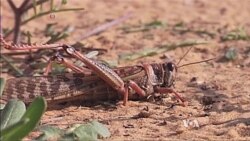In Argentina, farmers and fumigators are desperately trying to control the worst locust plague in more than half a century. Swarms of the large grasshoppers in the dry forests of the north threaten to devastate crops and grasslands used for cattle grazing. A swarm of locusts — often in the millions or even billions — can destroy an entire cropland in minutes.
For now, early intervention with insecticides is key to controlling the insects before they start to swarm. But many poor countries, from South America to Africa to Asia, lack those resources.
Math vs. insects
Now, a team of researchers in England has created a mathematical model of a locust swarm that may lead to new strategies to control their migration. That may even include breaking up the swarm by using aircraft.
The scientists studied video of different-sized groups of locusts that had been put into a small, ring-shaped arena, and watched their interaction.
One of the observers, Christian Yates, a mathematical biologist at the University of Bath, said, "While swarming, locusts usually move in the same direction as their immediate neighbors, but then spontaneously switch direction together as a group."
However, when just a few locusts were put into the arena, they didn't pay much attention to each other, he added.
That changed "as soon as you put more locusts into the arena,” Yates said. “They all start to march together in the same direction, so either clockwise or anti-clockwise, and occasionally spontaneously, these locusts will all switch direction at the same time and start to move in the other direction around the arena."
The numbers
It doesn't take many locusts to start a swarm, Yates said.
"The most important thing we found in our research was that if you take two locusts coming in one direction, and one in the other, then these two locusts can turn this individual," he said.
What this all means, Yates said, is that locusts are sensitive to uncertainty, and because of that, aircraft may break up a swarm.
"So one option is to maybe fly planes close to the locusts, which will increase the disturbances in the air," he explained.
Other possibilities include "using some sort of ultrasonic device to disturb the locusts."
But he said the best way to deter locust plagues in Argentina and elsewhere is to prevent the insects from breeding and swarming in the first place.














